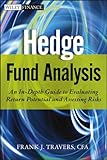Hedge fund analysis : an in-depth guide to evaluating return potential and assessing risks / Frank J. Travers.
Material type: TextSeries: Wiley finance seriesPublication details: Hoboken, N.J. : Wiley, 2012.Edition: 1st edDescription: 1 online resourceContent type:
TextSeries: Wiley finance seriesPublication details: Hoboken, N.J. : Wiley, 2012.Edition: 1st edDescription: 1 online resourceContent type: - text
- computer
- online resource
- 9781118227107
- 1118227107
- 9781118237564
- 1118237560
- 9781118264744
- 1118264746
- 9781119204855
- 1119204852
- 332.64/524 23
- HG4530
- BUS036000
Includes index.
"Hedge Fund Analysis will provide a broad framework covering the hedge fund due diligence process from initial screening to analytical techniques, interviewing skills, and legal and contract negotiations. Having guided the reader through the selection process, it will demonstrate a variety of mechanisms for monitoring and tracking hedge funds and the underlying hedge fund portfolios. This comprehensive guide will explain each stage of the process in minute detail, providing specific examples which fully explain the benefits and pitfalls that can occur on each step of the way. Every analytic tool and technique available will be explored, and arguments will be supported with examples of real situations. This book has five sections. Section 1 will provide a detailed background and illustration on how to source hedge funds and how to screen through them (there are 7,000+ of them out there, so screening is critical). Section 2 will lay out a thorough process for evaluating the funds, from initial interviewing to performance analysis to a primer of interviewing techniques, including both verbal and non verbal communication (body language). Section 3 will break out what questions to ask by strategy. It is important to know what key risk factors are by strategy and to ask the "right" questions. Each major strategy will have its own chapter that will discuss the strategy, associated risks and a detailed list of questions (along with right and wrong responses). Section 4 incorporates non-investment analysis such as operational due diligence and risk management. Section 5 shows how to evaluate all the components of the due diligence process to rank a hedge fund's strengths and weaknesses. This section will also cover how to put together a portfolio of hedge funds and how to monitor investments once they are made"-- Provided by publisher.
Machine generated contents note: IntroductionPart One: BackgroundChapter 1: Hedge Fund HistorySo Who Invented the Hedge Fund?NotesChapter 2: Hedge Fund Asset ClassDefinitionHedge Fund StructureHedge Fund StrategiesAdvantages of Allocating to Hedge FundsHedge Fund Size Impacts PerformancePart Two: Hedge Fund Due DiligenceChapter 3: Due Diligence ProcessKey Areas of Focus within each Component of Due DiligenceThe Due Diligence Process Highlighted in this BookPutting it all TogetherSome Initial ThoughtsChapter 4: Initial Data CollectionData CollectionDue Diligence Questionnaire (DDQ)Fictional Capital ManagementOther MaterialsFurther Analysis13F AnalysisHedge Fund JournalChapter 5: Initial InterviewInitial Call or MeetingPhone InterviewsMeeting NotesChapter 6: Quantitative AnalysisPerformance MeasuresAbsolute Return MeasuresAbsolute Risk MeasuresRegression Based StatisticsPeer Group AnalysisChapter 7: Portfolio AnalysisAttribution AnalysisFundamental AnalysisEvaluating Portfolio DataChapter 8: Onsite InterviewsOnsite Meeting StrategiesOne-on-One MeetingsMeeting with More than One PersonDifferent PerspectivesMeeting NotesOnsite Interviews at Fictional Capital Management (FCM)Chapter 9: Operational Due DiligenceCase Study: Bayou FundDefinitionImportance of Operational Due DiligenceCategorization of Operational Due DiligenceInterview with FCM Operational StaffNotesChapter 10: Risk Due DiligenceGraphical Depiction of Hedge Fund RisksRisk Due DiligenceFactor Decomposition AnalysisInterview with FCM Risk managerNotesChapter 11: Reference and Background ChecksOnlist and Offlist ReferencesInternet and Social MediaContacting ReferencesProblematic ReferencesWhose References should you Check?How Many Reference Calls are Enough?Background ChecksSummary of Reference Calls for FCMChapter 12: Hedge Fund Scoring Model and Decision MakingHedge Fund Scoring ModelPutting it all TogetherAbout the AuthorIndex.
Print version record and CIP data provided by publisher.
Includes bibliographical references and index.
Part One. Background. Chapter 1. Hedge Fund History -- Chapter 2. Hedge Fund Asset Class -- Part Two. Hedge Fund Due Diligence. Chapter 3. Due Diligence Process -- Chapter 4. Initial Data Collection -- Chapter 5. Initial Interview -- Chapter 6. Quantitative Analysis -- Chapter 7. Portfolio Analysis -- Chapter 8. Onsite Interviews -- Chapter 9. Operational Due Diligence -- Chapter 10. Risk Due Diligence -- Chapter 11. Reference and Background Checks -- Chapter 12. Hedge Fund Scoring Model and Decision Making.
Media and Communication
